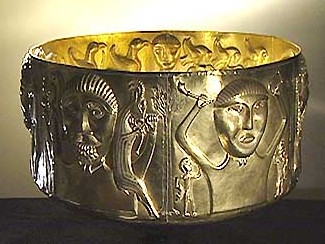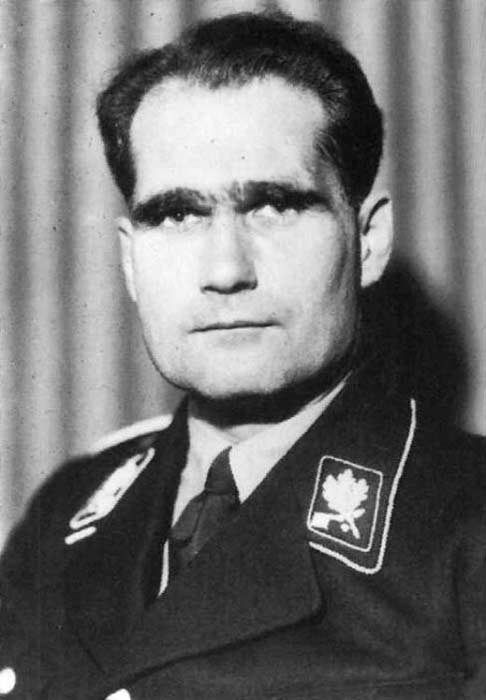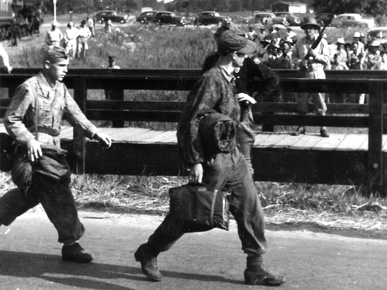 |
 |
 |
 |
 |
 |
 |
 |
 |
 |
 |
 |
 |
 |
 |
 |
 |
 |
 |
 |
 |
 |
 |
 |
 |
 |
 |
 |
 |
 |
 |
 |
 |
 |
 |
 |
 |
 |
 |
 |
 |
 |
 |
 |
 |
 |
 |
 |
 |
 |
 |
 |
 |
 |
 |
 |
 |
 |
 |
 |
 |
 |
 |
 |
 |
 |
 |
 |
|
|
The History of the Lebor Feasa Runda |
|
|
|
 |
|
|
 |
|
|
|
|
|
 |
|
|
|
|
|
|
|
|
The story behind the discovery of the ancient Celtic text from which the present translation of the Lebor Feasa Runda was made spans many centuries, but the events surrounding it in the days leading up to and during World War II are perhaps the most critical to its being made available to modern readers.
During the late 1930's the German Reichsfuhrer, Heinrich Himmler, learned of the existence of the ancient manuscript known as the Lebor Feasa Runda that had been recorded in an Old Irish text known as the Black Book of Loughcrew, which had been brought to
Prague in the 1580's by the English occultist, Dr. John Dee, under the patronage of Emperor Rudolf II. By the 1930's the manuscript had fallen into the |
|
|
|
 |
|
|
|
|
|
Ahnenerbe linguist Henry Thorenson was assigned to translate the Lebor Feasa Runda into German by order of Reichsfuhrer Heinrich Himmler in 1938 |
|
|
|
|
hands of the German Thule Society from whose possession Himmler ordered it confiscated.
Turned over to the Ancestral Heritage Research and Teaching Society known as the Ahnenerbe Forschungs-und Lehrgemeinschaft for translation, the task of deciphering the Old Irish text fell upon a young German linguist named Heinrich Thorensen who was assigned by the Ahnenerbe to translate the ancient Gaelic text into German. |
|
|
The Nazi's interest in the Lebor Feasa Runda stemmed from the fact that the text mentions a mysterious island called Tir nan'Og that once existed in the Atlantic Ocean and was considered to be the realm of the Celtic gods, which the Nazis believed to be the equivalent of Thule, an island that they considered to be the original homeland of the Aryan race. |
|
|
 |
|
|
|
|
|
The Lebor Feasa Runda may have inspired the creation of this World War II era "Celtic" style cauldron, made from 24 pounds of solid gold. The cauldron was deposited in Lake Chiemsee as part of an occult ceremony conducted by the Third Reich as an offering to the ancestral gods to help secure Nazi victory in World War II. The cauldron was later recovered by a diver in 2001. |
|
|
|
|
|
The Lebor Feasa Runda also mentions four great treasures possessed by the Celtic gods which were believed to weild amazing powers. Convinced that these mystical objects were the equivalents of such legendary artifacts as the Holy Grail, the Spear of Destiny, the Stone of Scone and the Sword Excalibur; Reichsfuhrer Heinrich Himmler sent the Ahnenerbe across the continent of Europe on a scavenger hunt to acquire these renowned treasures. |
|
|
The manuscript containing the Lebor Feasa Runda mysteriously disappeared from the Ahnenerbe archives on May 10th, 1941, the date Rudolf Hess made his solo flight to Scotland with the intention of conducting a secret meeting with the Duke of Hamilton and other high-ranking British aristocrats to discuss peace negotiations between Germany and Britain. The meeting was to have taken place at Dungavel House, the country estate of the Duke of Hamilton, but Hess was unable to locate the private landing strip at Dungavel in the dark of night and was forced to bail out of his unarmed aircraft when it ran out of fuel. Parachuting from his plane, |
|
|
|
 |
|
|
|
|
|
Hitler's deputy Fuhrer, Rudolf Hess, took the ancient manuscript containing the Lebor Feasa Runda with him intending to present it as a gift to the Duke of Hamilton, whom Hess planned to meet with in Scotland on May 10th, 1941 |
|
|
|
|
Hess injured his ankle on impact and was quickly apprehended and taken into custody by a local guard unit. Among those who had seen the items removed from Hess was a young man by the name of John Paterson, who recalled that Hess had been carrying a very old book of some sort that looked to be an ancient manuscript which Hess said he had intended to present to the Duke of Hamilton as a gift of goodwill. No meeting between Hess and the Duke was to take place however; within a few days Hess was sent by rail to London by order of British Prime Minister, Winston Churchill, who had Hess detained as a prisoner for the duration of the war. The items confiscated from Hess were turned over to the British Secret Service and were kept in a sealed file after the war, but when the file's seal was found broken in 1991, the contents of the file were missing. |
|
|
|
 |
|
|
Right: The wreckage of the Messerschmitt Bf 110 in which Rudolf Hess made his secret flight to Scotland was recovered by British military authorities from Bonnyton Moor. Hess had bailed out of his unarmed aircraft when it ran low on fuel while he was attempting to locate the private landing strip at Dungavel House, where Hess had planned to meet with the Duke of Hamilton to discuss peace negotiations between Germany and Great Britain in an attempt to end the conflict between the two countries. |
|
|
|
|
|
|
 |
|
|
|
Left: Family photograph of Douglas Hamilton, 14th Duke of Hamilton and 11th Duke of Brandon on the grounds of his country estate at Dungavel House in Lanarkshire, Scotland. Rudolf Hess had intended to present the ancient Gaelic manuscript containing the Lebor Feasa Runda to the Duke as a gift of friendship between Germany and Britain.
Below: Dungavel House, the estate of the Duke of Hamilton and Rudolf Hess' intended destination for his solo flight to Scotland on May 10th, 1941 |
|
|
|
|
|
 |
|
|
|
 |
|
|
Right (center): Winston Churchill, Britain's Prime Minister, the man Rudolf Hess held responsible for the outbreak of World War II, was initiated as a member of the Albion Lodge of the Ancient Order of Druids at his family's home, Blenheim Palace, in August 1908. When Hess arrived in Scotland, Churchill had him arrested and kept as a prisoner throughout the duration of the war. |
|
|
|
|
|
|
Although Rudolf Hess had apparently taken the original manuscript containing the Lebor Feasa Runda with him on his peace mission to Scotland, Heinrich Thorensen, the linguist assigned by the Ahnenerbe to translate the Old Irish text into German, had retained a personal copy of his transcription in his journal which he managed to keep with him even while he was taken prisoner by Allied forces in 1943. Heinrich Thorensen was later sent to Camp Aliceville, a detention facility constructed for the internment of German war prisoners in the United States. |
|
|
|
 |
|
|
 |
|
|
|
|
Heinrich Thorensen, the Ahnenerbe's German translator of the Lebor Feasa Runda arriving at Camp Aliceville with other German war prisoners, carrying the journal containing his transcription of the Lebor Feasa Runda |
|
During his detention at Camp Aliceville Henry's
only contact with relatives in Germany was through letters such as this one which were carefully censored by the military before being forwarded on to the recepient. |
|
|
|
|
|
Following his release from Camp Aliceville in 1946, Heinrich Thorensen remained in the United States, changing his name to Henry Thorenson. Marrying a local girl named Evelyn who had worked in the kitchen of the internment camp, Henry settled down to live a normal life, working as a school teacher, and went on to finish his German translation of the Lebor Feasa Runda |
|
|
|
during the 1960's, when he sought to be of assistance in securing Rudolf Hess' release from Spandau Prison, after the last of the other prisoners except for Hess had been paroled. |
|
|
|
Despite all the efforts made on his behalf, Hess remained in Spandau as the prison's only inmate until his death under mysterious circumstances at the age of 93 in 1987. Hess had been found strangled with an electric cord in the prison's greenhouse. The official cause of his death was ruled to be suicide.
Although Henry Thorenson died in 1991 without ever having published his German translation of the Lebor Feasa Runda, his widow, Evelyn, kept his work enabling the present English translation to be made and published. |
|
|
|
 |
|
|
|
The copy of Henry Thorenson's unpublished German translation of the Lebor Feasa Runda that his widow Evelyn provided to Steven L. Akins, allowing him to translate this mysterious text of Irish origin into English; at long last making the beliefs and teachings of the Celtic Druids available to readers throughout the world for the first time in centuries. |
|
|
|
 |
|
|
 |
|
|
|
|
|
 |
|
|
|
|
|
|
|
|
click here to return to the main page |
|
|
|

|
|















